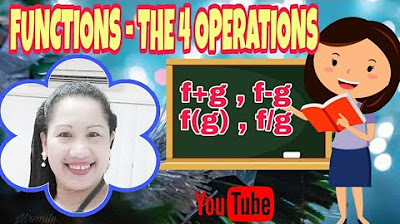POLINÔMIOS #02 | ADIÇÃO E SUBTRAÇÃO COM POLINÔMIOS | \Prof. Gis/
Summary
TLDRIn this educational video, Gis teaches the fundamentals of adding and subtracting polynomials. The content begins with an explanation of polynomial addition through real-life examples like calculating the perimeter of a triangle and trapezoid. Gis breaks down how to identify and combine like terms. Moving on to polynomial subtraction, she emphasizes the importance of sign rules when performing operations. Additional examples, including those involving fractions, help clarify the concept. The lesson encourages viewers to subscribe to the channel for more in-depth tutorials on polynomial operations like multiplication and division.
Takeaways
- 😀 Addition and subtraction with polynomials is an important concept that helps in simplifying and solving mathematical expressions.
- 😀 A perimeter of a polygon can be represented as a polynomial, where each side of the polygon is a term in the polynomial.
- 😀 When adding polynomials, it's essential to group similar terms (i.e., terms with the same variables) and combine their coefficients.
- 😀 A trinomial is a polynomial with three terms, while a polynomial can have any number of terms.
- 😀 Polynomials with different terms (like 3x + 5 or 3x^2 + 2xy) should be treated carefully during addition or subtraction to ensure the correct terms are combined.
- 😀 To subtract polynomials, distribute the minus sign properly and then combine similar terms. Pay attention to the sign changes.
- 😀 An independent term in a polynomial does not contain a variable, and it should be handled separately during addition or subtraction.
- 😀 It's important to use the rule of signs when subtracting polynomials, especially when handling negative signs and ensuring proper term changes.
- 😀 When combining terms, ensure that you do not alter the literal parts (like 'x' or 'y')—only the coefficients are combined.
- 😀 For polynomials involving fractions, finding the least common denominator (LCD) can simplify terms and make the addition or subtraction process easier.
Q & A
What is the main topic covered in this video?
-The main topic covered in the video is the addition and subtraction of polynomials.
What is the definition of a polynomial perimeter as explained in the video?
-A polynomial perimeter is represented by a polynomial expression that adds up the lengths of all sides of a polygon. Each side's length is expressed as a term in the polynomial.
How do you perform addition with polynomials?
-To add polynomials, you group similar terms (terms with the same literal part), and then add the coefficients of those terms while keeping the literal part the same.
What are 'similar terms' in the context of polynomials?
-Similar terms are terms that have the same literal part (variables with the same exponents). Only the coefficients of these terms are added together.
What is the special name for a polynomial with three terms?
-A polynomial with three terms is called a trinomial.
Can you subtract polynomials, and if so, how?
-Yes, polynomials can be subtracted. When subtracting, you must apply the sign rule (distribute the minus sign), and then group and subtract similar terms.
What does 'reduced form' mean in polynomial addition or subtraction?
-Reduced form refers to the simplified version of a polynomial where similar terms have been combined and no further simplifications are possible.
What is the purpose of using parentheses when subtracting polynomials?
-Parentheses are used to indicate that the terms inside must be subtracted, and the minus sign outside the parentheses changes the signs of the terms inside according to the sign rule.
How do you handle polynomials that contain fractions?
-When adding or subtracting polynomials with fractions, you first find a common denominator (using the least common multiple), adjust the fractions accordingly, and then proceed with the addition or subtraction.
What is the importance of the sign rule in polynomial operations?
-The sign rule is crucial for correctly subtracting polynomials. It ensures that the signs of the terms are correctly adjusted before performing the addition or subtraction of the coefficients.
Outlines

Esta sección está disponible solo para usuarios con suscripción. Por favor, mejora tu plan para acceder a esta parte.
Mejorar ahoraMindmap

Esta sección está disponible solo para usuarios con suscripción. Por favor, mejora tu plan para acceder a esta parte.
Mejorar ahoraKeywords

Esta sección está disponible solo para usuarios con suscripción. Por favor, mejora tu plan para acceder a esta parte.
Mejorar ahoraHighlights

Esta sección está disponible solo para usuarios con suscripción. Por favor, mejora tu plan para acceder a esta parte.
Mejorar ahoraTranscripts

Esta sección está disponible solo para usuarios con suscripción. Por favor, mejora tu plan para acceder a esta parte.
Mejorar ahoraVer Más Videos Relacionados

POLINÔMIOS #01 | DEFINIÇÃO FORMA REDUZIDA E GRAU DE UM POLINÔMIO | \Prof. Gis/

A-Level Maths: B6-01 [Polynomials: Introducing Polynomials]

Penjumlahan, Pengurangan, dan Perkalian Suku Banyak Polinomial | Matematika SMA

Penjumlahan dan Pengurangan Polinomial Suku Banyak | Matematika SMA

Operation on Functions/Teacher Espie

How to Divide Polynomials Using LONG DIVISION | Math 10
5.0 / 5 (0 votes)
